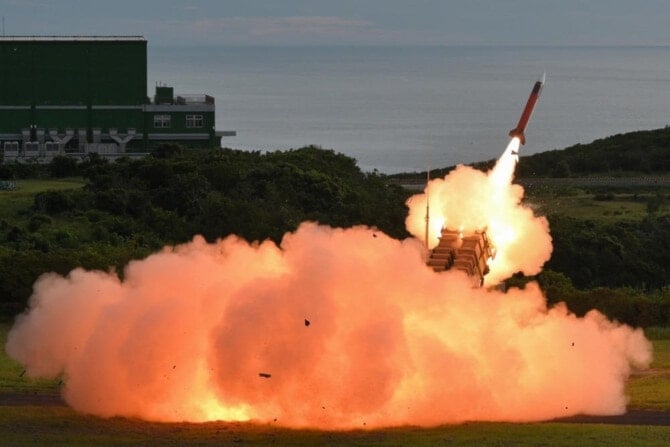US drafts contingency plans for Taiwan: Report
The plans reportedly include the deployment of a US Marine regiment equipped with HIMARS along Japan’s Nansei island chain, which stretches from Kyushu to Yonaguni, close to Taiwan.
-

Above, a US-made MIM-104 Patriot surface-to-air missile is launched during a live fire exercise at the Chiupeng missile base in Taiwan’s Pingtung county on Aug. 20, 2024. (AFP)
The United States is preparing contingency plans for potential military deployments in Japan and the Philippines in the event of what it described as a Taiwan-related emergency, according to a report by Japan's Kyodo news agency. These plans will be part of the first joint operation plan set to be finalized in December, sources familiar with Japan-US relations revealed.
The plans reportedly include the deployment of a US Marine regiment equipped with HIMARS (High Mobility Artillery Rocket System) along Japan’s Nansei island chain, which stretches from Kyushu to Yonaguni, close to Taiwan.
According to the report, if a Taiwan contingency becomes imminent, temporary bases would be established on inhabited islands. This approach reportedly aligns with US military guidelines, which emphasize deploying marines in small units across multiple locations.
Japan’s role would primarily involve logistical support for the marine unit, such as providing fuel and ammunition. In addition, the US Army plans to station Multi-Domain Task Force long-range fire units in the Philippines, as per the news agency.
The Japanese and Philippine defense ministries did not immediately respond to requests for comment. While the US embassy in Manila declined to comment, the Chinese embassy in Manila stated it had "noted" the Kyodo report.
The big picture
Washington has been reinforcing regional alliances, conducting regular deployments of ships and fighter jets in the Taiwan Strait and South China Sea, actions that have drawn strong objections from Beijing.
The Nansei Islands, located near Taiwan, are considered a critical geographic buffer, making their defense a strategic priority.
As part of the broader "Pivot to Asia" (or "Rebalance to Asia"), the US began shifting diplomatic, military, and economic resources toward the Asia-Pacific region.
Over the years, military cooperation between the United States and its allies in the region has intensified, with increased joint exercises, arms sales, and the deployment of advanced military assets aimed at provoking China.
Read more: Japan, Australia, US boost Pacific militarization with joint drills
China has viewed these joint military drills as provocative actions aimed at containing its influence in the region. Beijing has recently intensified its military activities in the South China Sea with the aim of defending its territorial claims.
Notably, China has expanded its coast guard fleet, deploying the world's longest patrol ships, such as the Haijing 5901 and Haijing 2901, to enforce its territorial claims in disputed waters.
The Wall Street Journal reported on November 4 that these vessels have been involved in confrontational actions, including ramming rival ships.

 3 Min Read
3 Min Read








